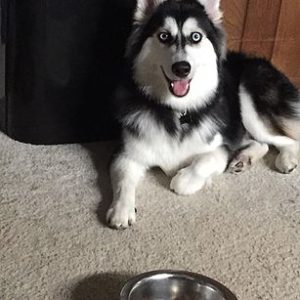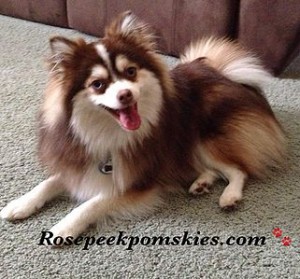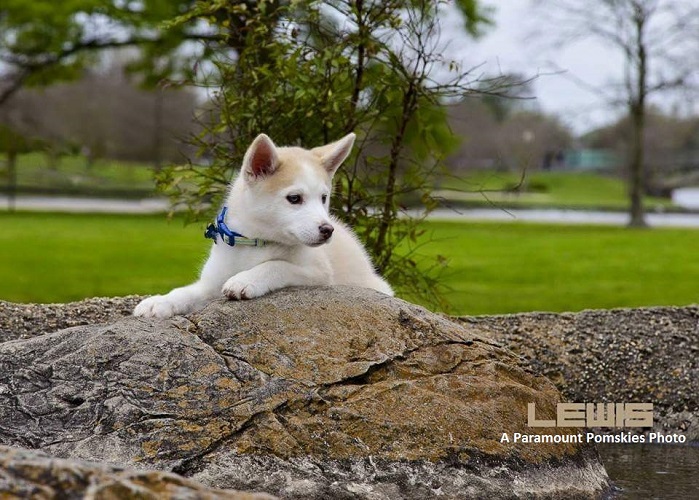Do Pomskies shed?
Yes, Pomskies shed!
Pomskies shed their dead hairs throughout the year and also blow their entire undercoat about twice a year. This means the Pomsky sheds a moderate amount over the course of the year and then sheds their entire undercoat over a short period, twice during the year. (Once during the Spring, and once during the Fall.) That said, there are things Pomsky owners can do to control the shedding.
*A big thank you to Karen McCullough from Maine Aim Ranch Pomskies and others who have helped with the information in this blog.*
Understanding the Pomsky coat
First you must understand the Pomsky coat. The Pomsky coat is soft, fluffy and silky. It’s a beautiful coat but the medium longish coat holds in a lot of dead hair, which then falls off of your pup as they run around and rub up on furniture. It’s important to understand that the Pomsky coat consists of both an undercoat and a topcoat (guard hair). The undercoat is what helps regulate body temperature, both in the summer and in the winter. So shaving your Pomsky is never a good idea! This will greatly affect how well your Pomsky regulates body temperature, and therefore how comfortable your Pomsky is.
It’s also important to understand that their are generally three types of Pomsky coats, which depends on the Pomsky generation you own:
- Standard coat
- Plush coat
- Wooly coat
Standard Pomsky coat
This is the shortest coat, similar to a Husky. The standard coat shouldn’t be confused as smooth and short-haired. It still has some fluff, but is the shortest of the Pomsky coats When the soft undercoat is blown twice a year, this makes the maintenance generally easier, as the topcoat doesn’t hold on to the released undercoat as much as the plush and wooly coats. We recommend using a slicker brush to control shedding. Find some slicker brushes here.

You can see a full grown 50/50 Pomsky has a shorter coat (standard) and more distinct Husky characteristics.
Plush Pomsky coat
This is the medium length for Pomsky coats. You’ll find more hair in the tail, legs, and around the face and ears. It’s generally more silky than the standard coat. When the undercoat is released, you are going to have a lot more hair getting caught with the topcoat. This will require more work to control the shedding. We highly recommend getting a grooming rake and going through the right process in controlling the shedding. (See one of our breeder’s recommended process below.)
Wooly Pomsky coat
This is probably the most desired or beautiful coats among Pomsky owners. It’s longer than the plush with a dense undercoat and will create a fluffier look. Similar to the plush, you’ll need more tools and a good process to control shedding.

You can see a 25/75 Pomsky coat is longer than that of a 50/50 (wooly). It is longer and more fluffy than the 50/50 Pomsky.
View all our our recommended brushes and grooming products for Pomskies.
Find A Pomsky – Click Here For Litter Updates
Tips for reducing Pomsky shedding
- Proper diet – a high protein diet with meat as the main ingredient (and limited fillers) can help to reduce excessive shedding. The meat-rich dog foods are more easily digested and absorbed, helping to control shedding and dry skin.
- Proper hydration – proper hydration reduce the chance of dehydration. Dehydration leads to dry skin, which can cause excessive shedding.
- Brush regularly – brushing removes the excess dead hair hanging on your Pomsky’s coat and redistributes your Pomsky’s skin oils into its fur, helping the fur stay healthy and in place.
- Bathe regularly – baths help to clean off the loose hair from your Pomsky.
- Use the proper tools – A slicker brush or rake should be used for Pomskies. Slicker brushes are used for dog breeds with medium length hair whereas rakes are used for dog breeds with long hair and thick undercoats. Slicker brushes are great for all coat types. A grooming rake is highly recommended for the plush and wooly coats, especially when they blow their coats.
Recommended process to control Pomsky shedding
Below is the process Karen McCullough from Maine Aim Ranch Dogs suggests for your Pomsky, especially when your Pomsky starts blowing his/her coat. The steps below will help speed up the process of your Pomsky letting go of the undercoat, reducing overall shed that you find around your living space. Karen also recommends making this process enjoyable for you and your pup. It’s a great time to bond and make your Pomsky feel great!
If you don’t have the right tools and/or time to really take care of your Pomskies coat, we highly recommend using a professional groomer.
Here are the steps Karen suggests:
- Use a high-powered blower to help release the undercoat and get the loose hairs out out of the coat
- Bathe with shampoo.
- Apply conditioner. (Karen uses Infusium conditioner). This helps shine the coat and releases tangles. Don’t totally rinse the conditioner out.
- Spray them with Sullivan’s Shock. This is detangles and helps give even more shine.
- Comb in the shock spray. Use a slicker brush for standard coats. (Karen suggests this Wahl’s brush). And a grooming rake for plush and wooly coats. (Karen suggests a Sullivan’s 6″ comb).
More Pomsky Resources
Need more help finding a Pomsky? Check out our other Pomsky articles and videos including:
- Free Download - Litter Updates and Reputable Breeders
- Article - How To Find a Pomsky Breeder
- Article - How To Avoid Pomsky Scams
- Article - Size of Adult Pomsky
- Article - The Cost of a Pomsky
- Article - Pomeranian Husky Mixes
Want updates every time a one of our top breeders has Pomskies available? Click here to join our litter alert email list (also download a list of all reputable breeders.
Find A Pomsky - Click Here For Litter Updates
Affiliate Disclosure
Some of the links throughout this article are affiliate links, meaning, at no additional cost to you, the Pomsky Owners Association will earn a commission if you click through the link and make a purchase.
We only promote products or services that we have personally used and truly feel deliver value to the Pomsky owner.
Please note that the Pomsky Owners Association has not been given any free products, services, or perks by these companies in exchange for mentioning them in this article. The only consideration is in the form of affiliate commissions or compensation from select products or services that we have used and recommend.


